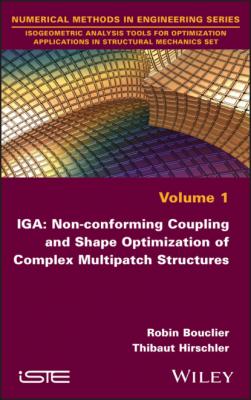IGA. Robin Bouclier
Чтение книги онлайн.
Читать онлайн книгу IGA - Robin Bouclier страница 18
 in a weak sense over Γ, using the Lagrange multiplier. This leads to the formulation of the following Lagrangian of the coupled problem:
in a weak sense over Γ, using the Lagrange multiplier. This leads to the formulation of the following Lagrangian of the coupled problem:
where the bilinear form b is defined such that:
With the above developments, we can finally obtain the classical Mortar coupling formulation of the reference problem as follows: find (u1, u2, λ) ∈
[1.43b]
[1.43c]
Thanks to the additional Lagrange multiplier field, the formulation is time variationally consistent. Moreover, the practical advantage of such a mixed formalism is that it enables us to keep the stiffness operators associated with the sub-domains separated and unmodified. Indeed, the communication between the sub-domains is performed via the Lagrange multiplier only. This feature is the basis of the non-overlapping domain decomposition methods developed for high-performance computing on parallel computer architectures (Farhat and Roux 1991; Farhat et al. 2001; Stefanica 2001, 2005; Gosselet and Rey 2006; Kleiss et al. 2012). Drawing inspiration from these techniques, in Chapter 3 we will develop a family of efficient algorithms for non-conforming isogeometric multipatch analysis. As of now, it may be quoted that system [1.43] will not be solved directly, but in an iterative way through the resolution of several local symmetric positive definite systems. Using the same idea, the additional field also enables us to simply build non-invasive coupling algorithms for multiscale computations: several different numerical models along with their related numerical codes can be coupled iteratively with the exchange of interface data only (Passieux et al. 2013; Guguin et al. 2014; Duval et al. 2016; Guinard et al. 2018). This opportunity will be investigated in Chapter 2 for global/local IGA. However, formulation [1.43] represents a saddle point problem, meaning that special care may be required for the construction of the approximation space of
NOTE.– In the context of Mortar approaches in IGA, it may be noted that a special interest is currently devoted to the dual Mortar resolution version (see, for example, Dornisch et al. (2015, 2017), Seitz et al. (2016), Zou et al. (2018) and Wunderlich et al. (2019)). The principle of this subclass of methods is to use dual-basis functions based on a biorthogonality concept to approximate
1.5.4. Nitsche coupling
Unlike Mortar approaches, the coupling is established from a primal formulation in the Nitsche technique. This time, both of the interface Dirichlet and Neumann conditions [1.36] are enforced in a weak sense. More precisely, a connection between the Nitsche and Lagrange multiplier couplings can be made (see, for example, Fritz et al. (2004) and Bazilevs et al. (2012)). Starting with the Lagrange multiplier method, the idea to obtain the Nitsche method is to replace the Lagrange multiplier by the mean interface resultant force coming from the displacement. We therefore define the average of the stresses and of the virtual stresses as follows:
and obtain the following Nitsche bilinear form:
[1.45]
where we again use the jump operator [1.40]. This bilinear form finally needs to be enriched with a stabilization term to ensure the ellipticity of the boundary value problem. Denoting the stabilization parameter by αnit, the stabilized variational formulation of the problem using the Nitsche approach can be written as follows: find (u1, u2) ∈
The main advantages of the Nitsche approach in comparison to other coupling techniques are its variational consistency, as well as the positive definiteness, symmetry and good conditioning properties directly obtained for the final coupled stiffness operator. In addition, the absence of auxiliary fields simplifies the theory. While in formulation [1.43], a suitable approximation space for the Lagrange multiplier needs to be chosen, the Nitsche approach [1.46] requires the choice of a suitable value for αnit. It has been shown that good estimations of αnit can be obtained, for example, by solving a generalized eigenvalue problem (Apostolatos et al. 2014b; Nguyen et al. 2014) or several local eigenvalue problems (Ruess et al. 2014; Jiang et al. 2015) over the interface. It is also worth mentioning at this stage that a non-symmetric version of the Nitsche method exists, which has the interest of being weakly stable without adding any stabilization terms (Schillinger et al. 2016a; Guo 2017; Hu et al. 2018). However, as with the penalty approach, the stiffness operators of the different sub-domains